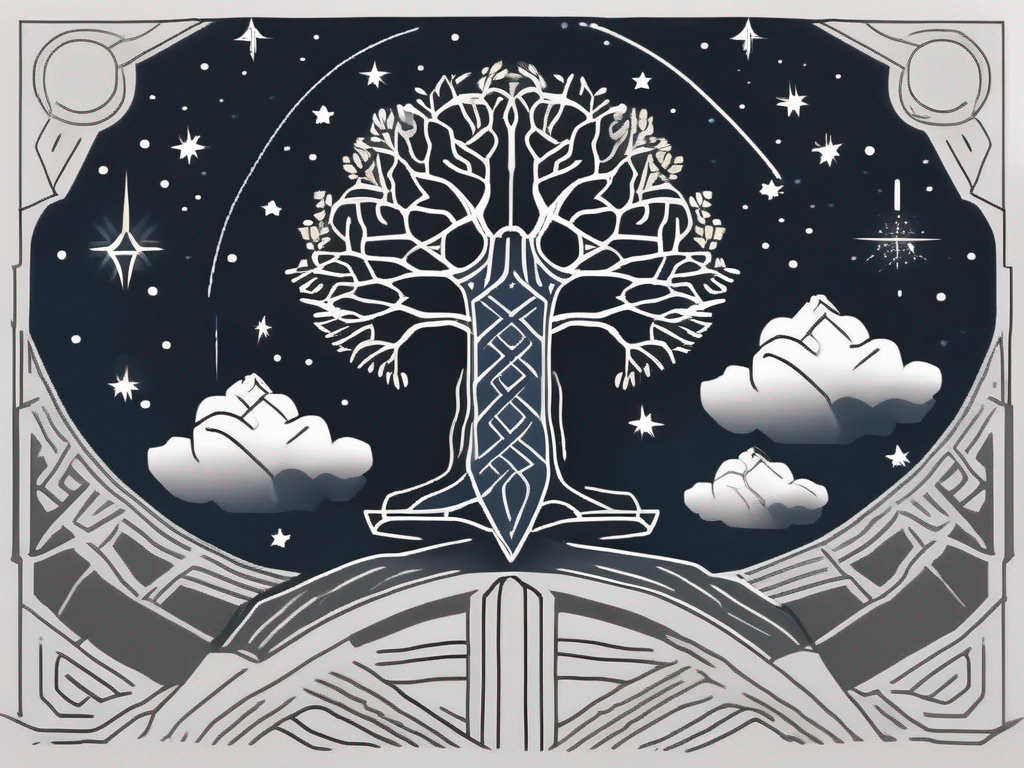In Norse mythology, Sif is a captivating goddess associated with beauty and fertility. Known for her long golden hair, Sif plays a significant role in the Norse pantheon. Let’s delve into the historical significance of Sif and explore her place among the gods and goddesses of old.
Understanding the Role of Sif in Norse Mythology
Sif is a complex figure in Norse mythology, embodying both beauty and fertility. She is often depicted as the wife of Thor, the mighty god of thunder. Sif’s role extends beyond her relationship with Thor, as she plays an integral part in various aspects of Norse culture and beliefs.
The Historical Significance of Sif
While much about Sif’s origins remains shrouded in mystery, she is believed to be one of the Aesir, the principal gods in Norse mythology. Sif’s presence in ancient Norse texts and her association with important rituals indicate her importance in the lives of the Norse people.
According to some accounts, Sif was born from the earth itself, emerging fully grown and radiant. Her golden hair, which is said to represent fields of wheat swaying in the wind, symbolizes her connection to fertility and abundance. As a goddess of beauty, she was revered for her ethereal appearance and captivating presence.
Sif’s relationship with Thor is a testament to her significance in Norse mythology. As the wife of the god of thunder, she represents the harmonious union of beauty and strength. Together, they embody the balance between the delicate and the powerful, a concept deeply ingrained in Norse culture.
Sif’s Place in the Norse Pantheon
Among the numerous gods and goddesses of the Norse pantheon, Sif holds a unique position. Her domains of beauty and fertility intertwined with everyday life, making her a revered figure among both gods and mortals. Sif’s connection to the natural world and agricultural cycles made her a patroness of the bountiful harvests.
It is said that Sif’s presence brings forth the blossoming of flowers, the ripening of fruits, and the growth of crops. Farmers and villagers would often offer prayers and sacrifices to Sif, seeking her blessings for a prosperous harvest. Her influence extended beyond the fields, as she was also believed to bring fertility to women and ensure the well-being of their children.
As a goddess of beauty, Sif was often invoked by those seeking to enhance their physical appearance or attract a suitable partner. Her radiant presence and enchanting aura were believed to bring good fortune in matters of love and relationships. Many would adorn themselves with golden jewelry or wear garments made from the finest materials as a tribute to Sif.
Despite her association with beauty and fertility, Sif was not merely a passive figure. She possessed a strong will and a fierce determination, often taking an active role in protecting her loved ones and defending the realms of the gods. Sif’s courage and resilience made her a symbol of strength and perseverance.
The Symbolism of Sif’s Golden Hair
One of the most distinctive features of Sif is her luscious golden hair, which holds great symbolism in Norse mythology. The tale of the theft and restoration of Sif’s hair highlights its significance and the connection it holds with fertility and abundance.
Sif, the beautiful goddess of fertility and harvest, is often depicted with flowing golden locks that shimmer like the sun’s rays. Her hair is not merely a physical attribute, but a symbol of her divine power and connection to the natural world.
The Theft and Restoration of Sif’s Hair
According to mythology, the cunning trickster god Loki once decided to play a mischievous prank on Sif. In her sleep, he snuck into her chambers and cut off her beautiful golden locks. As Sif awoke to find her hair gone, a sense of loss and vulnerability washed over her.
Learning of this, Thor, Sif’s husband and the god of thunder, was enraged and threatened Loki with dire consequences unless her hair was restored. He knew the importance of Sif’s hair and the role it played in the fertility of the land.
Loki, known for his craftiness, sought the help of the dwarves, skilled craftsmen and creators of powerful artifacts. They took on the task of creating magical hair for Sif, which seamlessly grew from her scalp. The dwarves used their mastery of metalwork and magic to fashion strands of gold that were as radiant as the sun itself.
When Sif’s hair was restored, it not only brought back her physical beauty but also symbolized the restoration of fertility and abundance to the land. The golden strands cascaded down her back, representing the golden fields of grain that would soon flourish once again.
The Connection Between Sif’s Hair and Fertility
Sif’s hair represents the abundance and growth of crops in Norse mythology. Just as her hair was cut and restored, the land goes through cycles of growth and harvest. The symbolism behind Sif’s hair serves as a reminder of the delicate balance between humans and the natural world, emphasizing the importance of agriculture and fertility.
As the goddess of fertility, Sif’s hair is not only a physical attribute but a manifestation of her power to nurture and sustain life. It is said that when Sif’s hair shines brightly, it is a sign that the crops will be bountiful and the people will thrive.
The golden hue of Sif’s hair is also associated with the sun, which plays a crucial role in the growth of crops. Just as the sun’s rays provide warmth and energy for the plants to flourish, Sif’s golden hair symbolizes the life-giving power of the sun and its connection to the fertility of the land.
In Norse mythology, the theft and restoration of Sif’s hair serves as a cautionary tale about the importance of respecting the natural world and the cycles of life. It reminds us that our actions have consequences and that we must strive to maintain harmony with nature in order to ensure the abundance and prosperity of future generations.
Sif as a Goddess of Beauty
Beyond her association with fertility, Sif is considered a goddess of beauty. Her aesthetics are reflected not only in her physical appearance but also in her influence on art and modern beauty concepts.
As a goddess of beauty, Sif’s allure and radiance were renowned in Norse mythology. Her captivating presence captivated the hearts of both gods and mortals alike. It is said that her beauty was so enchanting that even the mighty Thor, her husband, was in awe of her grace.
In Norse art, Sif is often portrayed as a radiant goddess, with her golden hair cascading down her back. Artists sought to capture her beauty and grace, depicting her as a symbol of allure and elegance. These artistic representations showcase the admiration the Norse people held for Sif’s beauty.
When it comes to beauty, Sif’s golden hair holds a special significance. It symbolizes not only her physical attractiveness but also her connection to the earth and fertility. In Norse mythology, her hair is believed to represent the golden fields of wheat, swaying gently in the wind, a reminder of the abundance and prosperity she brings.
While Norse mythology may seem distant from modern beauty ideals, Sif’s influence can still be seen today. Her portrayal as a goddess of beauty resonates with the pursuit of physical attractiveness and the appreciation of natural charm. Sif’s enduring presence in mythology continues to inspire artists and individuals alike to celebrate beauty in all its forms.
Moreover, Sif’s influence extends beyond physical beauty. She embodies the concept of inner beauty, emphasizing the importance of kindness, compassion, and strength of character. In a world that often places too much emphasis on external appearances, Sif serves as a reminder that true beauty comes from within.
Throughout history, Sif’s beauty has inspired countless works of art, literature, and music. Poets have penned verses praising her ethereal charm, while painters have attempted to capture her essence on canvas. Even in modern times, Sif’s influence can be felt in the beauty industry, where her name is often evoked to represent products that promise to enhance one’s natural beauty.
It is important to note that Sif’s beauty is not limited to a specific standard or ideal. She represents the diversity of beauty, embracing different forms, colors, and features. Sif’s beauty is a celebration of uniqueness, reminding us that we are all beautiful in our own way.
Sif as a Goddess of Fertility
Alongside her role as a goddess of beauty, Sif is deeply connected to fertility and the agricultural cycles that sustain life.
The Role of Sif in Agricultural Rituals
Sif’s connection with fertility extends to the agricultural rituals of the Norse people. She was venerated during important ceremonies, where offerings and prayers were made to ensure bountiful harvests. Sif’s benevolence and association with fertility acted as a source of hope for the prosperity of the Norse communities.
Sif’s Association with Harvest and Abundance
As a goddess of fertility, Sif was closely tied to the cycles of nature. The successful growth of crops and a plentiful harvest were attributed to her influence. It was believed that Sif’s watchful gaze blessed the fields and ensured an abundant supply of food for the Norse people.
Sif’s Relationship with Thor
Sif’s marriage to Thor, the thunder god, is a significant aspect of her story. This union not only solidified her place in the pantheon but also influenced Thor’s character and actions.
The Marriage of Sif and Thor
The marriage of Sif and Thor united two powerful forces within the Norse pantheon. Sif’s beauty and fertility complemented Thor’s strength and thunderous might. Together, they epitomized the harmonious balance between beauty and power, highlighting the essential nature of both aspects of existence.
Sif’s Influence on Thor’s Character and Actions
Thor’s love for Sif is well-documented in Norse mythology, and her presence in his life had a profound effect on his character. Sif’s influence tempered Thor’s potential for destruction, reminding him of the beauty and fertility that exist alongside his thunderous nature. This union emphasized the importance of balance and restraint in carrying out one’s responsibilities.
In conclusion, Sif, the Norse goddess of beauty and fertility, holds a vital place in Norse mythology. As a symbol of beauty, she embodies the aesthetics and allure that captivated the Norse people. Her connection to fertility and agriculture reinforces the significance of the natural world in sustaining life. Sif’s partnership with Thor exemplifies the delicate balance between power and gentleness, reminding us of the intricate dynamics that shape our existence. Despite the passage of time, Sif’s influence endures, inspiring us to embrace beauty and appreciate the abundance that surrounds us.












